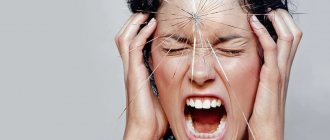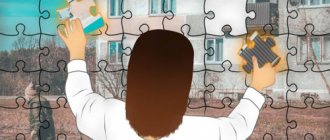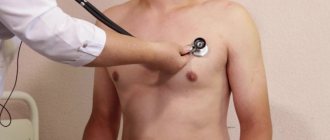When treating this symptom, an integrated approach is used that helps reduce its intensity and remove the cause of the neurotic disorder. Several types of assistance are used for this.
In life, a person faces various situations that strain his nervous system: there is no way to respond to grievances, fear arises due to a lack of a sense of security, it is not possible to implement plans, and so on. All conflict situations and shocks do not remain without a trace in the body. As a result of the action of psychotraumatic factors, a person develops the disease neurosis . It begins almost imperceptibly and manifests itself differently in everyone. Symptoms and external manifestations of the disease depend on the duration of the traumatic situation, its severity and individual reaction to it.
What is neurosis?
Neurosis is a disease in which a person loses the ability to cope with stressful situations . The body’s defenses and the formed psychological adaptation “break down” in this state, leading to exhaustion of the nervous system. This disease affects not only the psyche and the nervous system; a person often notices a malfunction of an internal organ or prolonged pain.
Subscribe to our INSTAGRAM account!
Strong neurosis does not go unnoticed from the outside either. People around note increased irritability and deterioration in the physical condition of a person suffering from this disease.
Causes of the disease
- An interesting fact is that not only situations associated with the loss of something close can lead to neurosis. The cause of the disease can also be a bright, joyful event , for example, the birth of a child, a wedding, or the start of studies at the desired college or university.
- Neurosis often occurs in melancholic and choleric people. These types of temperament are characterized by emotional instability, so typical melancholic and choleric people have a more difficult time experiencing traumatic situations.
- Physical and psycho-emotional stress ultimately lead to this nervous pathology. If a person constantly works or studies and does not have enough time for relaxation and rest, he is at risk. Especially with accompanying problems in your personal life, the development of neurosis cannot be avoided.
- With long-term or intense somatic illnesses, psychological problems associated with the inability to finish the work started, symptoms of severe neurosis also appear.
How does this disease manifest itself?
A neurotic disorder of the nervous system necessarily leads to detrimental consequences for the body and social activity of a person. It can cause neurosis, nausea, dizziness, constant headaches, increased conflict, irritability, and disability. That is why, when neurosis manifests itself, you need to solve the problem, and not hope for its independent disappearance .
The main manifestations of the disease include:
- headaches of various types;
- numbness of the limbs;
- dizziness;
- various types of sleep disorders;
- a person cannot relax if he wants to;
- increased irritability;
- the patient does not feel joy and happiness, he is constantly depressed;
- restlessness, anxiety;
- decrease in cognitive functions, intellectual abilities;
- fast fatiguability;
- pain in internal organs, in the limbs, without obvious reasons;
- decreased labor productivity;
- mood swings;
- tearfulness;
- touchiness;
- “getting stuck” in a stressful situation;
- the body's sensitivity to temperature changes and bright light;
- disorders of the autonomic nervous system: sweating, rapid heartbeat, fluctuations in blood pressure, problems with the stomach;
- decreased sex drive;
- decrease in the intensity of volitional impulses;
- dyspnea;
- dark spots when closing or opening the eyes, the condition is accompanied by dizziness;
- decreased appetite, inability to form a bolus due to insufficient amount of saliva in the mouth;
- the appearance of a feeling of fear without a threatening factor.
Causes
The etiological factor leading to the development of tension headaches can be a large number of pathological conditions occurring in the body. The main causes of tension headaches include:
- Frequent stressful situations. After studies conducted to study the clinical course of tension headaches, it was concluded that pain most often develops in the second half of the working day after significant stressful situations or as a result of prolonged hard work.
- Violation of rest and wakefulness. One of the most common causes of cephalgia. Constant lack of sleep or poor quality of night sleep leads to insufficient restoration of the central nervous system, which causes overstrain and headaches.
- Starvation. Malnutrition, rare or monotonous nutrition leads to insufficient supply of nutrients to brain tissue and dystrophic manifestations in neurons, primarily manifested in the form of cephalgia. A special case of fasting is the development of a hypoglycemic state, in which the brain lacks glucose.
- Hypertension or isolated arterial hypertension. An increase in systolic pressure leads, or less commonly, a decrease, which can cause the development of tension cephalgia of a vascular nature.
- Premenstrual syndrome is a common cause for women. It has been observed that tension headaches occur more often in females, especially during premenstrual syndrome.
Reduced severity of physiological symptoms
The listed signs manifest themselves differently in each patient. For some, neurosis is accompanied by only a few symptoms of the listed manifestations, and some note almost all of the listed changes in their body. Among the common symptoms, patients note headache, nausea, dizziness, tension in the body and head.
Tension in the body
This is the main companion of the disease. Neurotic disorders are almost always accompanied by muscle tension. This phenomenon occurs for both physiological and psychological reasons. In the human body, an uneven distribution of muscle load occurs, and dystonic reactions appear.
Some researchers argue that tension in any part of the body is associated with specific psychological problems. For example:
- Feelings of hostility towards others lead to tense arm muscles.
- Increased muscle tone in the thighs and pelvis in adulthood is caused by sexual problems.
- Tension in the head during neurosis is caused by deep emotions, unresolved conflicts, and low self-esteem of a person.
Psychological problems are very closely related to somatic manifestations. That is why it is necessary to get rid of this symptom as part of a set of measures to overcome a neurotic disorder.
With neurosis, constant tension in the body is treated not only with medications, but also with active use of physical exercises. They are prescribed depending on which muscles cannot relax. The following would be appropriate here:
- relaxation massages;
- various water treatments;
- medications for severe symptoms;
- working with a psychologist, psychotherapist to solve the cause of muscle tightness.
Nausea with neurosis
Not all doctors associate this symptom with psychological problems. Only experienced gastroenterologists or therapists refer the patient for a consultation with a psychotherapist or neurologist when experiencing nausea. Nausea with neurosis can last from several hours to several days. And it should not be associated with low-quality food and take sorbents or bacteria for the intestinal flora - there will be absolutely no result.
Constant nausea in neurosis is often observed with a feeling of disgust towards an object, person or activity, if the patient has accumulated grievances, he is dissatisfied with his life, his health or appearance. Constantly interacting with what a person considers unworthy or bad, neurosis will manifest itself through the main symptom - nausea.
There are two treatment options:
- reducing the severity of symptoms, short-term techniques using antipsychotics or antidepressants;
- long-term psychotherapy aimed at eliminating not only the symptom, but also the causes of neurosis.
Dizziness with this disease
It is enough to associate this phenomenon with the pathology of the nervous system, since dizziness during neurosis is not always accompanied by problems with internal organs. A person may complain of weakness and dizziness, although when tested, all results will be within the normal range; blood pressure measurements will also not show any pathology. In this case, we can safely say that the symptom is caused by psychogenic causes.
Dizziness occurs with depression, panic attacks, vegetative-vascular dystonia, phobias, and anxiety. It is complemented by noise in the head, increased irritability and sleep disorders. With dizziness of a psychogenic nature, it is impossible to cure a person of them without the use of psychotherapeutic techniques.
If dizziness is accompanied by hearing problems and gait disturbances, then we may be talking about disturbances in the functioning of the vestibular apparatus. In this case, an ENT doctor provides assistance. With changes in blood tests and examinations of the cardiovascular system, dizziness is caused by neurological or vascular diseases. A doctor working with a patient cannot immediately diagnose psychogenic dizziness, so first a negative diagnosis should be made - eliminating the physiological causes of the symptom.
In the treatment of dizziness due to neurosis, medications, special gymnastics and breathing exercises, as well as psychotherapeutic techniques are used.
Headache due to neurosis, causes
Headache is a faithful companion of neurasthenia and hysteria; it is practically not observed in obsessive-compulsive neurosis. This symptom does not occur immediately after a stressful situation, but after a certain period of time, after the development of other symptoms, for example, sleep or appetite disorders.
Headache with neurosis manifests itself in different ways, depending on the location of pain and the human organs involved. It develops due to:
- Muscle “clamps”.
- Disturbances in the functioning of cerebral vessels.
- Without disruption of muscles and blood vessels.
As a result of this classification, the symptoms of headaches with neurosis will be slightly different.
Neuromuscular pain is accompanied by:
- feeling of squeezing of the head;
- numbness of some parts of the surface of the head;
- sensation of pain on the skin surface of this part of the body;
- a person feels constant tension in the head, which interferes with mental processes: it is difficult to remember something, concentrate attention, or decide.
The neurovascular nature of pain will be expressed through the following symptoms:
- throbbing pain in the head;
- pulsation constantly focuses a person’s attention on pain, he cannot perform any complex mental work;
- often localized in the temporal region, occipital and frontal;
- accompanied by nausea and weakness.
Headache without muscle tension and pulsation in a neurotic disorder occurs after overwork. It does not have a clear localization, and it is difficult to understand the nature of the pain. Its occurrence is associated with psycho-emotional experiences, so it is classified as neurotic symptoms.
Symptoms of tension headaches
The attack can last from 30 minutes to a week. Dull, pressing headaches occur. Many patients feel as if their head is being squeezed by a hoop. The muscles of the head, neck, and shoulders become tense. Sometimes sensitivity to light and sounds increases.
The diagnosis is usually made after a conversation and examination by a doctor. It is important for a neurologist to understand how severe the attacks are, how often they occur, where and how your headache hurts.
If the symptoms seem unusual to the doctor, or other diseases are suspected, you may be prescribed a computed tomography, magnetic resonance imaging, or other tests.
Our doctors will help you
Message sent!
expect a call, we will contact you shortly
How to get rid of neurotic headaches?
It is important for patients with a neurotic disorder to know how to relieve tension and pain in the head during neurosis, because their livelihoods depend on it. When treating this symptom, an integrated approach is used that helps reduce its intensity and remove the cause of the neurotic disorder. To achieve this, several types of patient assistance are used.
Medication assistance
With neuroses, pain in the head can be simply unbearable. A constant feeling of heaviness, constriction and increased severity of pain leads to a deterioration in the patient’s psycho-emotional state. He becomes irritable, gets tired quickly, and does not want to use anything for food, since the chewing process also causes pain. To solve this problem, it is necessary to use medications to get rid of headaches. To do this, the doctor prescribes:
- sedative herbal preparations (Valerian, Peony Tincture, preparations with motherwort, Nervo-Vit);
- painkillers that relieve muscle or vascular spasm (Spazmolgon, Riabal, Novigan, various analgesics and others);
- vitamins to support the functioning of the heart and nervous system (various vitamin complexes with vitamins C, group B, magnesium, iron and other microelements);
- nootropics and anti-anxiety drugs (Glycised, Glycine, Nootropil, Pantogam), they have a good effect on brain function and normalize sleep, but the dosage and course of administration are determined only by a doctor.
Psychotherapeutic assistance
Psychological techniques are used not only to treat headaches, but also to get rid of the causes of neurosis. Cognitive behavioral therapy is actively used, hypnosis is an effective assistant, and it is also important to use positive therapy methods to restore a person’s psycho-emotional sphere. Long-term work with a psychologist or psychotherapist is required.
Lifestyle change
Often a person causes himself to develop neurotic headaches by exposing himself to excessive mental or physical stress.
To avoid the development of this symptom into pathology, restoration of the body's strength is required: healthy sleep, work and rest regime, you can help yourself by using aromatherapy, therapeutic exercises, doing massages, water procedures, tuning into the positive and learning positive thinking. Published by econet.ru.
PS And remember, just by changing your consciousness, we are changing the world together! © econet
The main areas of treatment for tension headaches are:
- To reduce immediate pain, it is possible to use painkillers and anti-inflammatory (anti-inflammatory) drugs, such as diclofenac, ibuprofen, nimesulide, naproxen.
- If there is tension in the muscles of the head, face and neck (pericranial muscles), it is possible to use muscle relaxants (drugs that relax muscles), such as mydocalm, sirdalud, baklosan.
- An integrated approach aimed at normalizing the emotional state: antidepressants (amitriptyline, fluoxetine), psychotherapy, autogenic (self-training) training.
- A very important aspect of treatment is to control the amount of painkillers taken, since their uncontrolled use can contribute to a new type of headache, the so-called abuse headache, which will be discussed in another article.
Of the non-drug treatment methods, the most effective are exercises aimed at relaxing the muscles of the head and neck, autogenic (self-training) training, biofeedback method, and psychotherapy.
In conclusion, I would like to emphasize that, despite the desire to provide in this article the most complete information about such a disease as tension headaches, you should not resort to self-diagnosis and self-medication, since, as practice shows, this not only can cause a blow to your health, but also cause a waste of time and material resources.
If you are concerned about the state of your health or the health of people close to you, do not put off visiting a doctor (neurologist).
To make an appointment with the specialists of the Pain Clinic, you just need to call the phone number or fill out the feedback form, and you can also make an online appointment with doctors on our website. Health and prosperity to you and your loved ones!









